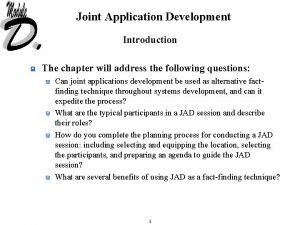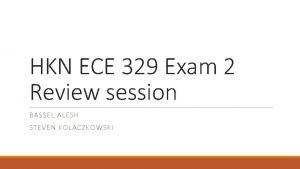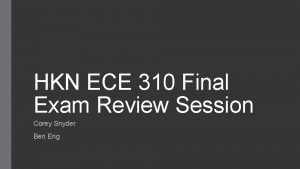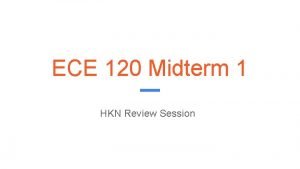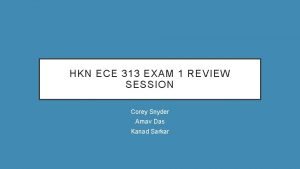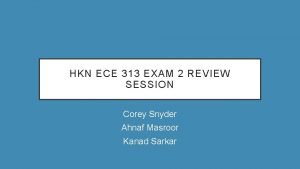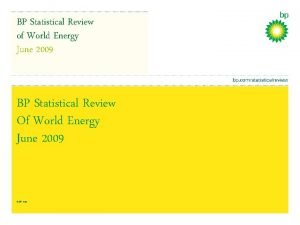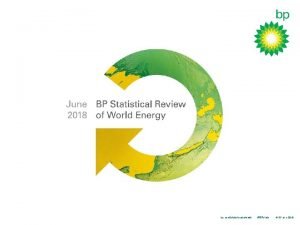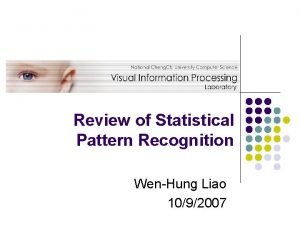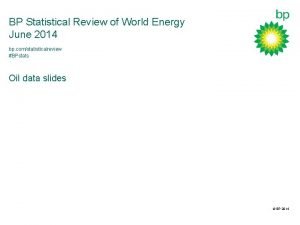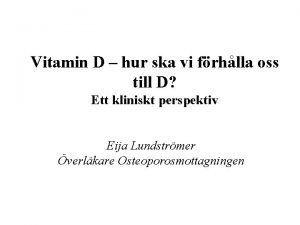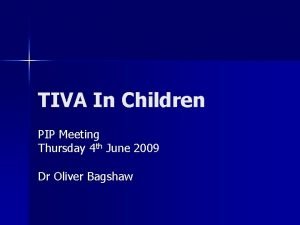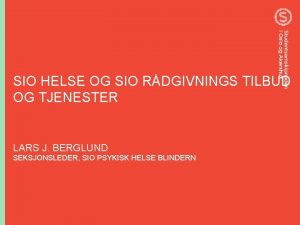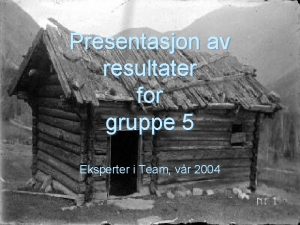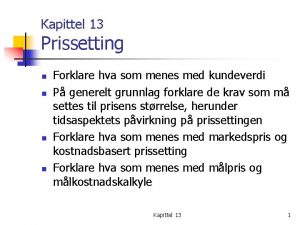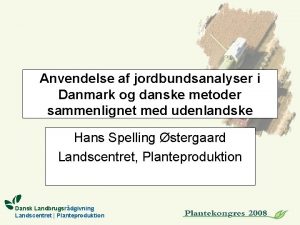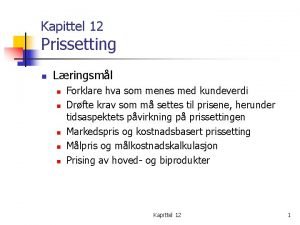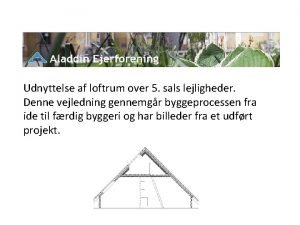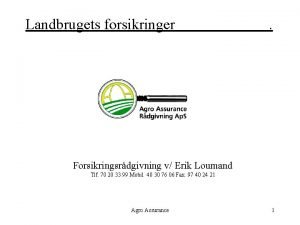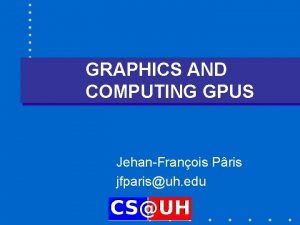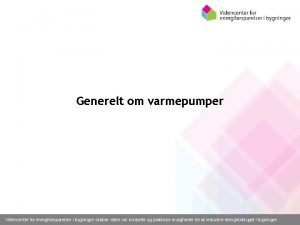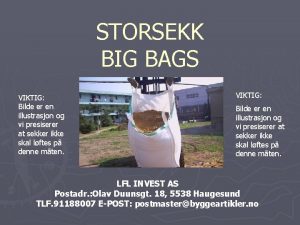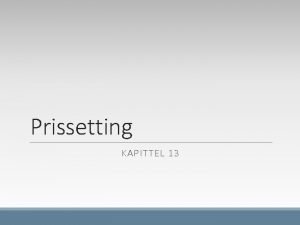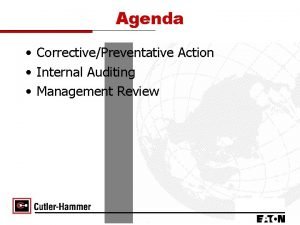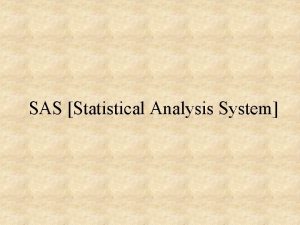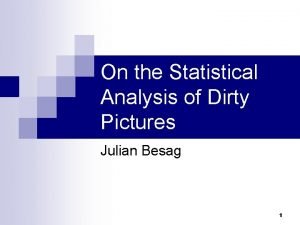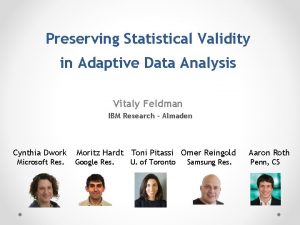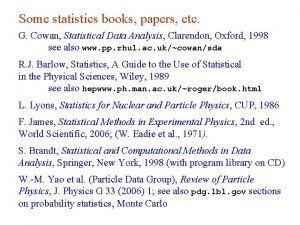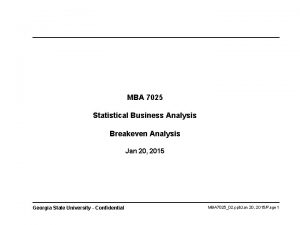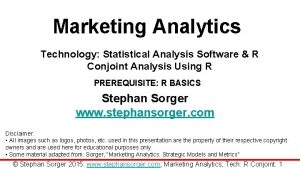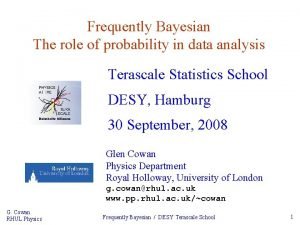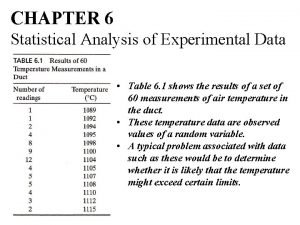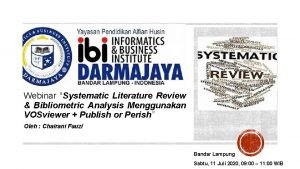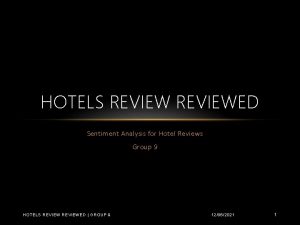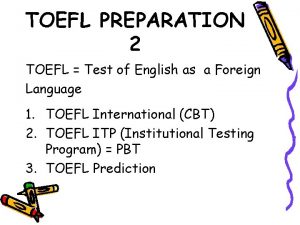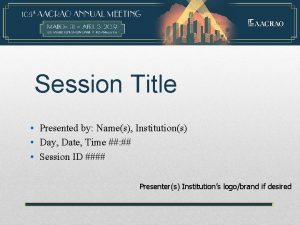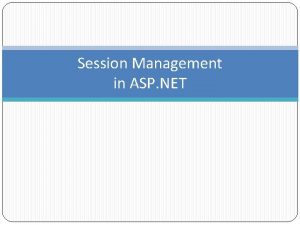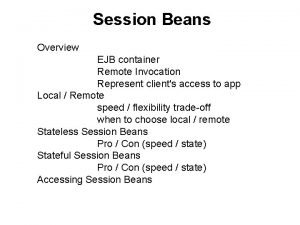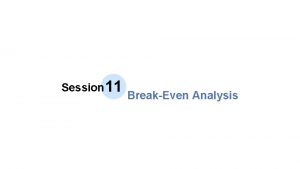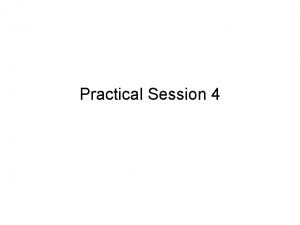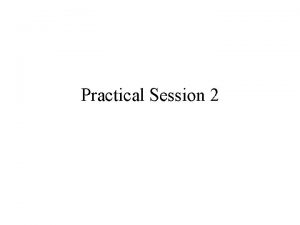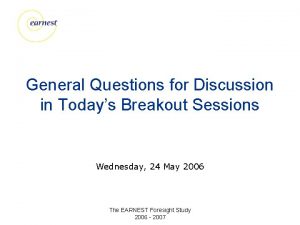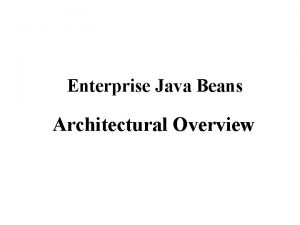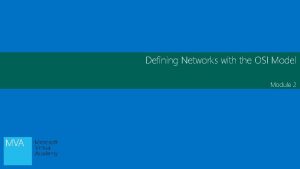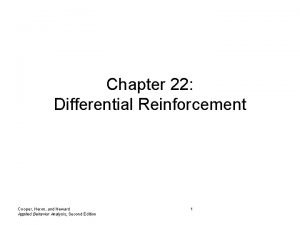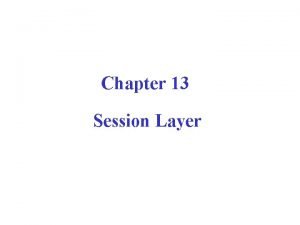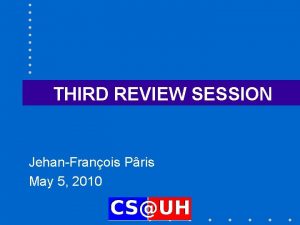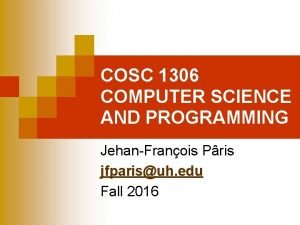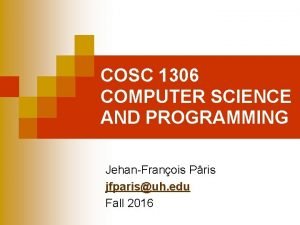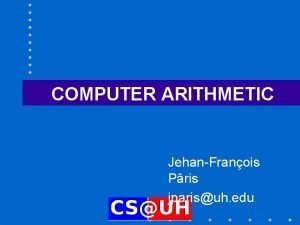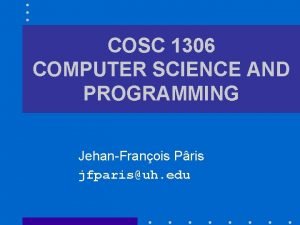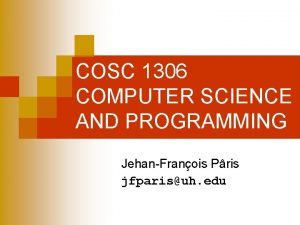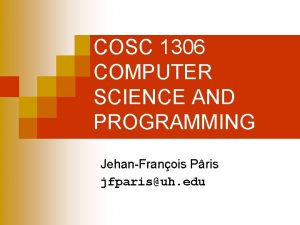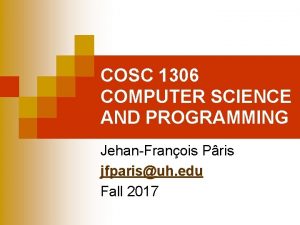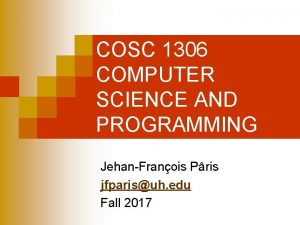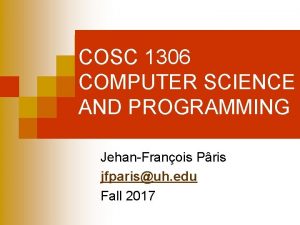Review Session JehanFranois Pris Agenda Statistical Analysis of




















































































- Slides: 84

Review Session Jehan-François Pâris

Agenda Statistical Analysis of Outputs n Operational Analysis n Case Studies n Linear Regression n

How to use this presentation n Most problems have ¨ One slide stating the problem ¨ One slide explaining how to solve the problem ¨ One slide allowing you to check your answer You will learn more by trying first to do the problems on your own than by reading their solutions n Do not forget either to review the problems in the original notes n

Statistical Analysis of Outputs

The big picture n The problems ¨ Constructing confidence intervals ¨ Handling auto correlated data n The tools ¨ Central-Limit Theorem ¨ Wilson’s formula ¨ Batch means (and regeneration) ¨ RNG tricks

Confidence Intervals n Distinguish between ¨ CIs for means n CSIM does it for you ¨ CIs for proportions n We are on our own n Major issue is independence of data points n CSIM uses batch means

Central Limit Theorem n If the n mutually independent random variables x 1, x 2, …, xn have the same distribution, and if their mean m and their variance s 2 exist then …

Central Limit Theorem n The random variable is distributed according to the standard normal distribution (zero mean and unit variance).

CI for means (I) n For large values of n, the (1 - )% confidence interval for m is given by n with

CI for means (II) n F(z) is taken from a table of the normal distribution ¨ F(0. 025) n For smaller values of n, we have to use Student’s t random variable ¨ Wider n = 1. 96 CIs We replace s by the sample standard deviation s

Example n We have ¨ 100 observations for the waiting time ¨ xbar = 4. 25 minutes ¨ s 2 = 25

Example n We have ¨ 100 observations for the waiting time ¨ xbar = 4. 25 minutes ¨ s 2 = 25 n Answer is ¨ 4. 25 ± 1. 96 sqrt(25/100) = 4. 25 ± 0. 98

CI for proportions n A proportion represents the probability P(X ) for some fixed threshold ¨ 97% of our customers have to wait less than one minute n Distributed according to a binomial law ¨ Use Wilson’s formula

Wilson’s formula n When n > 29, we can use the Wilson’s interval where za/2 = 1. 96 for a 95% C. I.

Example n We have want to estimate the proportion of packets that wait more than four slots ¨ 400 observations ¨ 40 packets waited more than four slots

Answer n Divisor: ¨ 1 n + 1. 962/400 1. 01 (instead of 1. 0096) Central term ¨ 0. 1 n + 1. 962/(2× 400) 0. 105 (instead of 1. 048) Half width ¨ sqrt( (0. 1× 0. 9)/400 + 1. 962/(2× 4002) ) sqrt (0. 09/400 + (4/800)/400) 1/20 sqrt (0. 09 +0. 0025) 0. 3/20 = 0. 015 n Result is ¨ (0. 105 ± 0. 015)/ 1. 01 = 0. 104 ± 0. 015

Batch means (I) n Simulation data are often autocorrelated ¨ Packet delays in ALOHA ¨ Waiting times in queues ¨… n Batch means reduce (but do not completely eliminate) that effect

Batch means (II) Group measurements into fixed-size batches of consecutive data n Compute mean of each batch n If batches are large enough, these means will be independent n ¨ Can n use standard-limit theorem, … In case of doubt, compute autocorrelation function for successive batch means

Regeneration (I) n The idea ¨ Partition simulation data into intervals such that n Data measured inside the same interval might be correlated n Data measured in different intervals are independent

Regeneration (II) n How? ¨ System goes to a regeneration point each time n Its queues become empty n All the disk drives are operational n… ¨ Criterion is system specific

Streams n When you want to evaluate two different configurations of a system, it is often good idea to use separate random number streams for arrivals and service times ¨ Arrival times remain unchanged when we change other parameters of the system

Operational Analysis

Single server (I) n We can measure ¨T the length of the observation period ¨ A the number of arrivals during the observation period ¨ B the total amount of busy times during the observation period ¨ C the number of completions during the observation period

Single server (II) n We can compute ¨l = A/T ¨ X = C/T ¨ U = B/T ¨ S = B/C n There are two ways to compute U ¨U n the arrival rate the output rate the utilization the mean service time = B/T = (C/T )(B/C) = XS In general A C and l X

Little’s law n n If W is the total time spent by all tasks inside the system over the observation period, then ¨N = W/T ¨R = W/C Since W/T = (C/T)(W/C) = XR, N = XR This is important

A problem n An ice-cream parlor ¨ Observed during 6 hours ¨ Visited by 120 customers ¨ Spend an average of 24 minutes inside n What is the average number of customers inside the parlor?

Answer n We compute X and apply Little’s Law

Answer n We compute X and apply Little’s Law ¨X = 120/6 = 20 customers/hour ¨ R = 24 minutes = 0. 4 hours ¨ N = XR = 8 customers

If you did not get it n The 120 customers sent a total of 120× 24 customer×minutes or 48 customer×hours in the parlor ¨ 48 n customer×hours/6 hours = 8 customers Same as having 8 customers spending six hours each inside the parlor

Network of servers (I) Open network Arrivals Departures

Network of servers (II) Closed network Arrivals Departures

Operational Quantities n Keep same quantities as before but add indices ¨ 0 for whole system ¨ k for individual servers n Two changes ¨ We never care about the utilization of the whole system ¨ We add number of visits Vk of each server

Operational quantities n Over the observation period, we measure ¨C = the number of job completions ¨ Ck = the number of tasks completed by device k n We define ¨ X 0 = C/T = the system throughput ¨ Xk = Ck/T = the output rate at server k ¨ Vk = Ck/C = the visit count at server k

Important relationships n Ck = Vk. C ¨ Since each job requires Vk visits, there are Vk more server completions than job completions n Xk = Vk X 0 ¨ Same property applies to throughputs

System response time (I) n We define Nbar = average number of jobs in the system ¨ nbari = average number of jobs at device i ¨ n Nbar = Σi nbari

System response time (II) n n Applying Little’s law, we have R = Nbar/X 0 and nbari = Ri. Xi = Ri. Vi. X 0 Hence R = Σ i V i. R i

Note n This result is trivial ¨ The total time spent by a job in the system is the sum of the times spent at each server n This includes the time spent waiting in the server queues

Problem 1 n A job requires ¨ 100 ms of CPU time ¨ 9 disk accesses Each disk access takes 7 ms n We want n ¨ VCPU and SCPU

Answer n We now that jobs get CPU first and last ¨ VCPU n = 10 Then ¨ SCPU = 100/10 =10 s

Bottleneck analysis (I) A system has one CPU and one disk drive n It processes transactions such that n n ¨ VCPU = 12 and SCPU = 5 ms ¨ VDisk = 11 and SDISK = 8 ms What is the maximum system throughput?

Bottleneck analysis (II) n We compute first the maximum device throughputs n Maximum XCPU = 1/0. 005 = 200 requests/s Maximum Xdisk = 1/0. 008 = 125 requests/s n Since Xi = Vi X 0 n ¨ Maximum throughput compatible with CPU workload is 200/12 = 16. 7 transactions/s ¨ Maximum throughput compatible with disk workload is 125/11 = 11. 4 transactions/s

Bottleneck analysis (III) n The disk is the bottleneck ¨ It has highest Vi. Si product n Identifying feature of any bottleneck device n Increasing the system throughput might require ¨ Sharing disk requests with a second disk ¨ Increasing the efficiency of the system I/O buffer

Problem 2 In the previous example, which device was the bottleneck? n What would be throughput of the system if the bottleneck utilization was 80%? n

Answer n We compare ¨ VCPUSCPU ¨ Vdisk. Sdisk

Answer n We compare ¨ VCPUSCPU = 100 ms ¨ Vdisk. Sdisk = 9× 7 = 63 ms n The CPU is the bottleneck

Answer n If the bottleneck was operating at 100% utilization, ¨ It could process one job each VCPUSCPU time units ¨ Or 1/(VCPUSCPU) job per time unit n At UCPU utilization, ¨ It will process UCPU/(VCPUSCPU) job per time unit

Answer n X 0 = UCPU/(VCPUSCPU) = 0. 80/0. 10 seconds ¨ 8 jobs/second

Systems with terminals Whole system M Terminals

Interactive response time formula n We have M terminals ¨ Think time Z between the completion of a job and the submission of the next job ¨ n Applying Little’s law to the whole system M = (R + Z ) X 0 then R = M/X 0 – Z Very Important

Problem 3 n We have ¨M = 50 users ¨ Z = 20 s ¨ X 0 = 2 transactions/s n What is the system response time?

Answer n We apply R = M/X 0 – Z

Answer n We apply R = M/X 0 – Z and obtain R = 50/2 – 20 = 5 seconds

Problem 4 n A system ¨ Processes 5 transactions/seconds ¨ Has 60 users ¨ Achieves a response time of 4 seconds n What is the think time?

Answer n We apply R = M/X 0 – Z, ¨ Z = M/X 0 – R

Answer n We apply R = M/X 0 – Z, ¨ Z = M/X 0 – R = 60/5 – 4 = 8 seconds

Problem 5 n We have ¨M = 50 users ¨ Z = 20 s ¨R = 4 s n What is the system throughput?

Answer n From R = M/X 0 – Z, we have X 0 = (R + Z)/M Hence X 0 = (20 + 4)/50 = 0. 48 tasks/s

Problem 6 n A system ¨ Can process up to 4 transactions/second ¨ Has 60 users ¨ User think time is 12 seconds n Can the system achieve a response time of 2 seconds?

Answer n Applying R = M/X 0 – Z, we compute a lower bound for the response time ¨ Rmin = M/X 0, max – Z

Answer n Applying R = M/X 0 – Z, we compute a lower bound for the response time ¨ n Rmin = M/X 0, max – Z = 60/4 – 12 = 3 seconds Answer is no

Problem 7 n Compute the response time of a system knowing the following parameters ¨M = 50 users ¨ Z = 15 s ¨ VCPU SCPU = 200 ms ¨ UCPU = 50%

Answer n Since Xk = Uk /Sk and Xk = Vk. X 0, X 0 = Uk /(Vk. Sk) n The response time is then given by R = M/X 0 – Z

Answer n Let us compute first the throughput X 0 ¨ Applying X 0 = Uk/(Vk. Sk) X 0 = 0. 50/0. 200 = 2. 5 interactions/s n The response time is then R = M/X 0 – Z = 50/2. 5 – 15 = 5 s

Simulation Case Studies

A simple reminder n If interarrival times are ¨Independent identically distributed (i. i. d. ) ¨According to an exponential law then the probability of having exactly n arrivals during a fixed interval is distributed according to a Poisson law

Explanation (II) n Assume that ¨ The probability of one arrival during a small interval Dt is l. Dt ¨ The probability of two arrivals during the same small time interval is negligible l. Dt

Explanation (I) n The probability of having exactly k arrivals during n slots is n What would happen if the number of time intervals goes to infinity while their total duration T = n. Dt remains constant

Explanation (III) n We rewrite the previous expression as and compute separately the limits of its four factors

Explanation (IV)

Explanation (V) n We obtain the Poisson distribution n The probability that there are no arrivals in the same time interval T (or in any time interval T) is

Explanation (VI) n n This last expression is the probability that the time interval between two consecutive arrivals is greater than T The probability that the time interval between two consecutive arrivals is equal or lesser than T is which is the cdf of the exponential distribution

A final observation n Use the Poisson distribution to generate number of arrivals during a time interval n Use the exponential distribution to generate interarrival times

Linear Regression

Most important point n Compute a regression line n Compute regression coefficient

Example

Linear Regression n We have ¨ one independent variable ¨ One dependent variable n We must find Y = + b. X n minimizing the sum of squares of errors Si (yi - - bxi)2

Formulas

Calculations (I)

Calculations (II)

Outcome

More notations

More notations (II) n Solution can be rewritten

Coefficient of correlation r = 1 would indicate a perfect fit n r = 0 would indicate no linear dependency n

Calculations
 Sample agenda for mentor meeting
Sample agenda for mentor meeting Joint application development
Joint application development Coaching session agenda
Coaching session agenda Welcome session agenda
Welcome session agenda Agenda sistemica y agenda institucional
Agenda sistemica y agenda institucional Ece 329
Ece 329 Direct form 2 structure
Direct form 2 structure Hkn review session
Hkn review session Hkn uiuc review sessions
Hkn uiuc review sessions Ece 329
Ece 329 Ece 391 mp3
Ece 391 mp3 Hkn review session
Hkn review session Bp statistical review of world energy 2009
Bp statistical review of world energy 2009 Bp statistical review
Bp statistical review Statistical pattern recognition a review
Statistical pattern recognition a review Bp statistical review of world energy 2014
Bp statistical review of world energy 2014 Divisun 2000 ie pris
Divisun 2000 ie pris Propofol.infusion syndrome
Propofol.infusion syndrome Sio lege
Sio lege Prisanalyse
Prisanalyse Tretak pris
Tretak pris Målsatt pris
Målsatt pris Konkurransemiddel
Konkurransemiddel Siemens synco pris
Siemens synco pris Ipma certificering pris
Ipma certificering pris Jordbundsanalyse pris
Jordbundsanalyse pris Biofyringsolje pris pr liter
Biofyringsolje pris pr liter Målsatt pris
Målsatt pris Indkøbsstyring business central
Indkøbsstyring business central Kartoffelpulp
Kartoffelpulp Regler udnyttelse af loftrum
Regler udnyttelse af loftrum Løsøreforsikring pris
Løsøreforsikring pris Gpu pris
Gpu pris Energibesparelser i bygninger
Energibesparelser i bygninger Varemerkeregistrering pris
Varemerkeregistrering pris Slidetodoc
Slidetodoc Ferdiggarasjer priser
Ferdiggarasjer priser Säga upp storytel telia
Säga upp storytel telia Målsatt pris
Målsatt pris Beskytte varemerke
Beskytte varemerke Project review agenda
Project review agenda Management review agenda
Management review agenda Statistical analysis system
Statistical analysis system On the statistical analysis of dirty pictures
On the statistical analysis of dirty pictures Preserving statistical validity in adaptive data analysis
Preserving statistical validity in adaptive data analysis Multivariate statistical analysis
Multivariate statistical analysis Cowan statistical data analysis
Cowan statistical data analysis Statistical business analysis
Statistical business analysis Amce conjoint
Amce conjoint Cowan statistical data analysis pdf
Cowan statistical data analysis pdf Statistical analysis of experimental data
Statistical analysis of experimental data Chapter review motion part a vocabulary review answer key
Chapter review motion part a vocabulary review answer key Ap gov review final exam review
Ap gov review final exam review Narrative review vs systematic review
Narrative review vs systematic review Example of inclusion and exclusion criteria
Example of inclusion and exclusion criteria Narrative review vs systematic review
Narrative review vs systematic review Vosviewer alternative
Vosviewer alternative Hotel review analysis
Hotel review analysis Swot analysis hbr
Swot analysis hbr Session 0 windows
Session 0 windows Welcome to the new session
Welcome to the new session Session
Session Skill 23 anticipate the topics
Skill 23 anticipate the topics Team norming session
Team norming session 6 session name
6 session name Conference session title examples
Conference session title examples Session tracking in asp.net
Session tracking in asp.net Stateful session bean life cycle
Stateful session bean life cycle Session break even
Session break even Eis portal principal per session
Eis portal principal per session Ergonomics session
Ergonomics session Practical session meaning
Practical session meaning Practical session definition
Practical session definition Define session in php
Define session in php What is the value of the staff-session cookie?
What is the value of the staff-session cookie? Interactive session poster
Interactive session poster Sample topics for lac session
Sample topics for lac session Breakout session questions
Breakout session questions Facilitate learning session
Facilitate learning session Javax.ejb.createexception jar
Javax.ejb.createexception jar Listening session template
Listening session template Behavior technician rbt session notes examples
Behavior technician rbt session notes examples Session protocol data unit
Session protocol data unit Define dri in aba
Define dri in aba Session layer function
Session layer function

